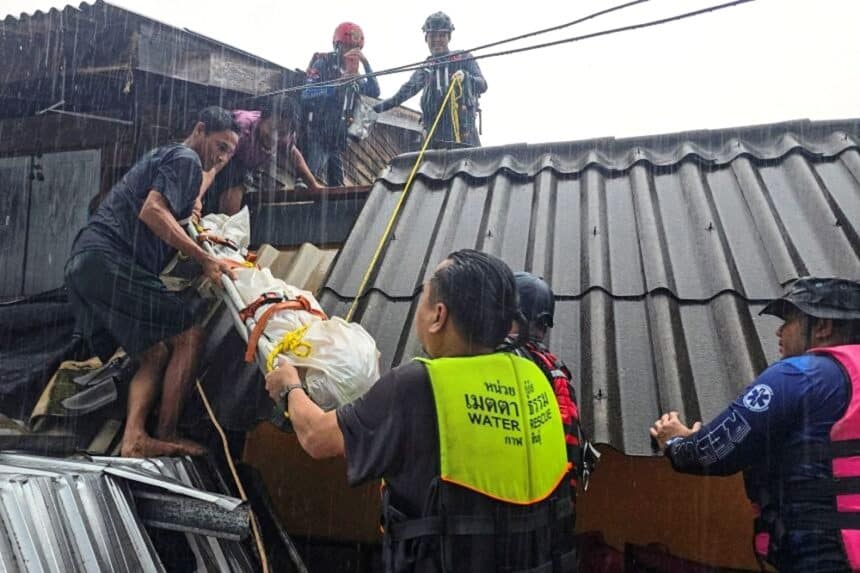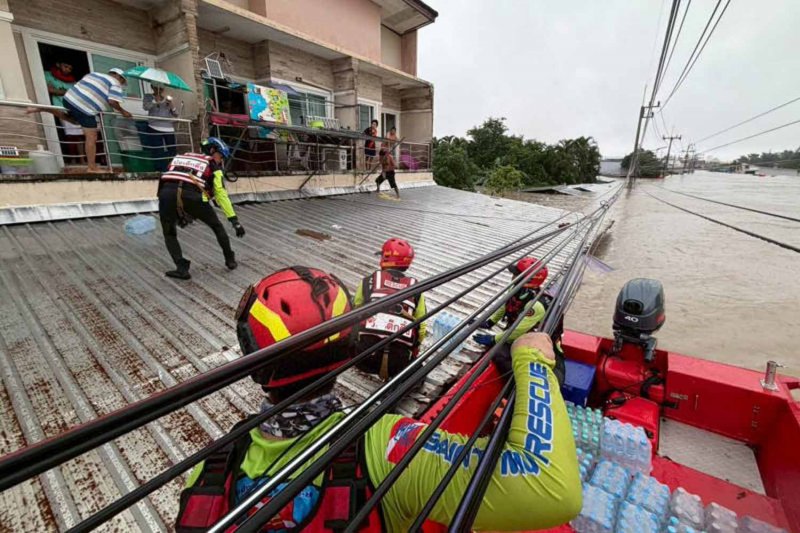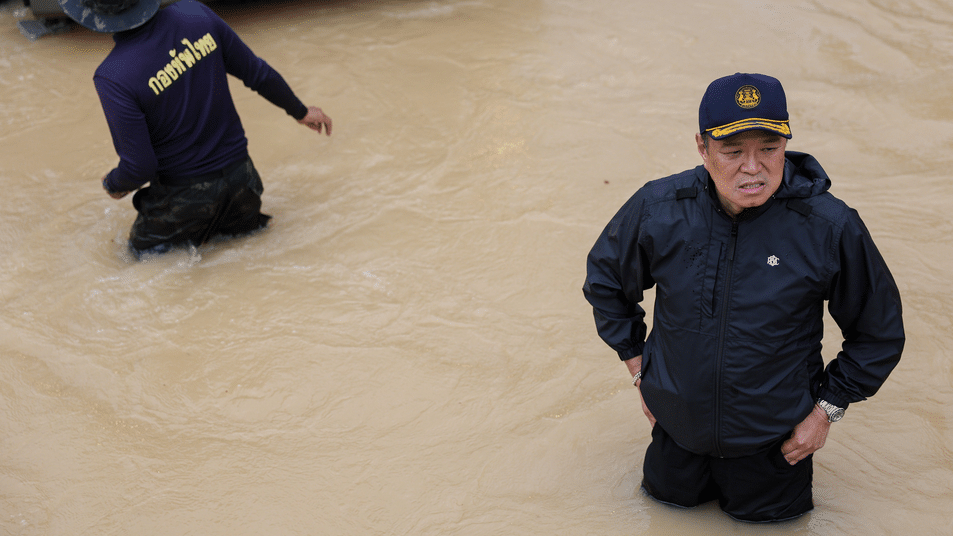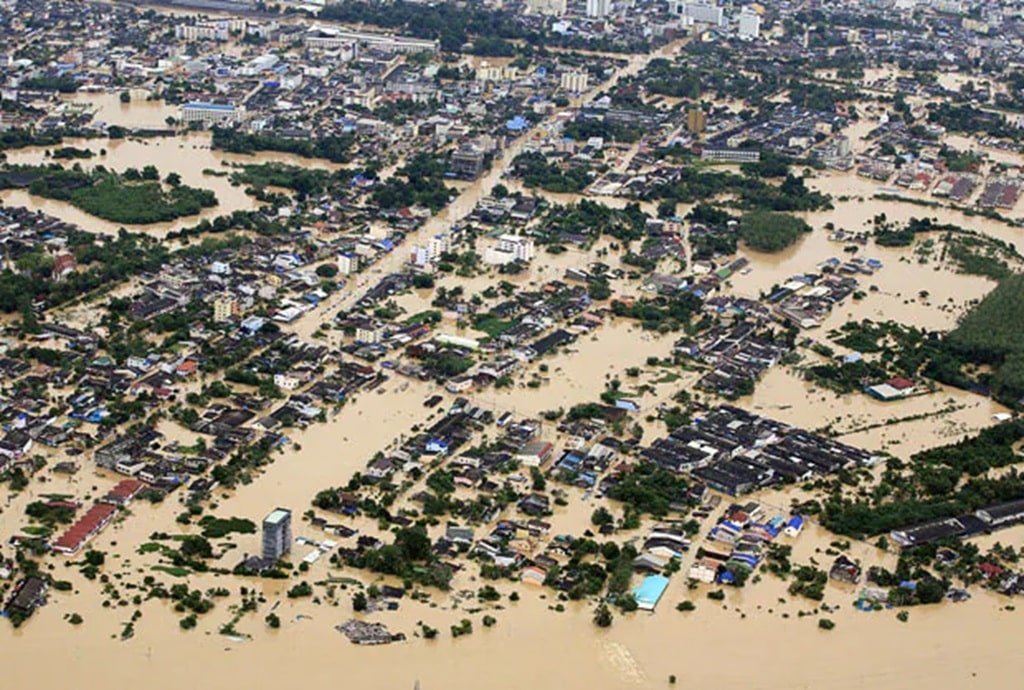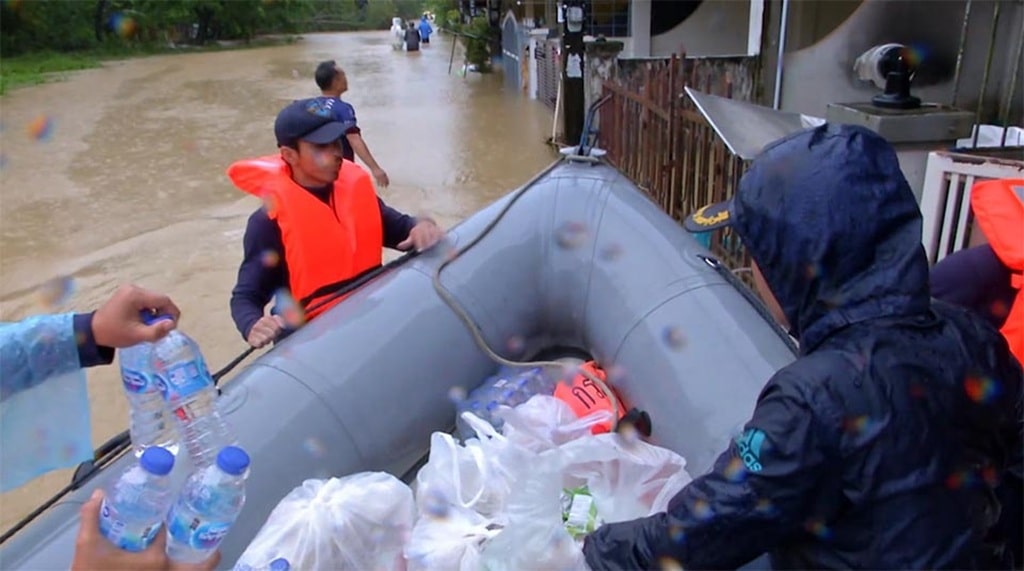BANGKOK – The Disaster Prevention and Mitigation Department reported on Wednesday that 33 people had died as a result of severe flooding in southern Thailand, while water levels kept rising in the most affected provinces.
Hat Yai remains one of the hardest-hit areas. Experts warn that the city’s commercial zone will likely stay underwater until at least mid-December. At 7 am on Tuesday, flood levels in parts of the city were almost two metres higher than they had been on Monday.
Government spokesman Siripong AngkasHave Claimed 33akulkiat said on Wednesday afternoon that 33 people had been killed in seven southern provinces: nine in Nakhon Si Thammarat, four in Phatthalung, six in Songkhla, two each in Trang and Satun, and five each in Pattani and Yala.
The reported causes of death included drowning, electric shock, and landslides.
The flooding, driven by days of heavy rain, continued in nine of the 14 provinces in the South. These are Surat Thani, Nakhon Si Thammarat, Trang, Phatthalung, Satun, Songkhla, Pattani, Yala, and Narathiwat.
More than 2.78 million people have faced serious disruption to their daily lives, and hundreds of thousands of homes are underwater.
The only slightly positive news came from the Meteorological Department, which forecast that the rain would gradually ease from Wednesday through to Monday next week.
Flooding is active in the following districts in the nine Southern Thailand provinces:
- Surat Thani: Tha Chang, Kanchanadit, Khian Sa, Phrasaeng
- Nakhon Si Thammarat: Cha-uat, Muang, Tha Sala, Phrommakhiri, Ron Phibun, Na Bon, Sichon, Chawang, Thung Song, Chalerm Prakiat, Hua Sai, Lan Saka, Bang Khan, Phra Phrom, Chang Klang, Pak Phanang, Chulabhorn, Nop Phi Tam, Thung Yai, Phipun, Chian Yai, Tham Phannara
- Trang: Na Yong, Huai Yot, Ratsada, Yan Ta Khao, Wang Wiset, Kantang, Muang, Sikao, Palian
- Phatthalung: Muang, Khuan Khanun, Kong Ra, Khao Chaison, Sri Nakarin, Bang Kaew, Pa Bon, Pak Phayun, Sri Banphot, Pa Phayom, Tamot
- Satun: Khuan Don, Langu, Tha Phae, Manang, Khuan Ka Long, Muang, Thung Wa
- Songkhla: Rattaphum, Muang, Chana, Khlong Hoi Khong, Ranot, Krasae Sin, Sathing Phra, Hat Yai, Khuan Niang, Na Thawi, Singha Nakhon, Na Mom, Bang Klam, Sadao, Thepha, Saba Yoi
- Pattani: Sai Buri, Mae Lan, Khok Pho, Mayo, Yarang, Mai Kaen, Yaring, Panare, Thung Yang Daeng, Kapho, Nong Chik, Muang
- Yala: Muang, Raman, Betong, Bannang Sata, Than To, Krong Pinang, Yaha, Kabang
- Narathiwat: Bacho, Yi-ngo, Muang, Rangae, Tak Bai, Sungai Padi, Sri Sakhon, Rueso, Sungai Kolok, Cho Airong, Sukhirin, Chanae
Songkhla has the highest number of affected households at 320,887, followed by Nakhon Si Thammarat with 223,221 households impacted.
Water levels continued to climb in most of the nine provinces. Surat Thani was the only one where the situation had started to improve, and levels were falling.
By Wednesday morning, the number of affected people had risen to 2.73 million. The Department of Health reported that around 20,000 displaced residents were staying in 273 temporary shelters.
Prime Minister Anutin Charnvirakul has promised to stay in Hat Yai to direct flood relief and evacuation work in person. He plans to return to Bangkok only when the situation becomes less severe or if urgent duties require him to go back. Reports indicate that the prime minister has cancelled all other official appointments for the week.
Prime Minister Anutin flew to Hat Yai again yesterday for his third visit in one week. He travelled on a C-130 military transport aircraft carrying equipment, food supplies, jet-skis, and volunteer drivers to support emergency relief and evacuation efforts. The situation remains critical after water spilled over from a reservoir late on Tuesday night.
On arrival, the prime minister and his small team received a briefing on the latest conditions and ongoing evacuations at the 42nd Army Circle headquarters. They then visited an evacuation centre at the Prince of Songkhla University stadium, followed by an inspection of flooded neighbourhoods in Hat Yai’s municipal area.
According to an official, water began to overflow from the reservoir within the Prince of Songkhla University compound at about 2 am and flowed into the urban area. The official warned that this overflow, together with the continuous rain, could make flooding in the city even worse.
Environmental expert Sonthi Kotchawat, from the Thai Environmental Scholars Association, said the South is facing one of its most serious natural disasters in many years. All 16 districts of Songkhla Province are flooded, with about 150,000 households affected, and Hat Yai is dealing with its worst flood since the year 2000. He said economic damage has already exceeded 500 million baht (about 15.4 million US dollars).
Why Hat Yai Flooded
Hat Yai lies on low-lying land that slopes towards Songkhla Lake, which makes it naturally prone to flooding when the lake level rises. The U-Taphao Canal, a 116-kilometre waterway running from Sadao District through central Hat Yai, carries water from several tributaries towards the lake.
The R.1 Canal, built as a royal project after the 2000 floods, was designed to divert part of the flow and speed up drainage. Runoff from the Bantad Mountain Range has surged into canals and spilled into homes in Phatthalung Province since 24 November 2025.
At the same time, water from several directions, including runoff from Khao Kho Hong and streams flowing down from the Nakhon Si Thammarat mountain range, all meet in the U-Taphao Canal before passing through Hat Yai.
Weather conditions have played a major part. A high-pressure system from China combined with a low-pressure monsoon trough and La Niña conditions to produce several days of very intense rainfall. Between 19 and 26 November, total rainfall reached 595 millimetres, higher than the peaks recorded in 2000 and 2010. Khao Kho Hong alone received 365 millimetres of rain on 22 November.
This runoff rushed into the waterways that feed the U-Taphao Canal, overwhelmed drainage systems, and caused floodwater to spill into Hat Yai’s city centre.
Flood Emergency Forward Command Centre
Sonthi said that water management in Thailand has been “far below standard” this year. He pointed to widespread flooding across all regions, despite early warnings about a highly unstable La Niña season.
He added that although disaster warnings went out one or two days in advance, the response on the ground has been slow. Many people in the southern provinces are still stranded without supplies while rescue teams struggle to reach them.
In the early hours of today, a large rain cloud was seen over southern Malaysia at about 3 am. It is moving towards Yala and Narathiwat provinces and Sadao District in Songkhla, where a canal starts that later flows through Hat Yai and out to sea.
Supreme Commander General Ukrit Boontanont, appointed by the prime minister to direct relief and evacuation operations in Hat Yai, has established the Flood Emergency Forward Command Centre at Air Wing 56 in Hat Yai.
The centre will coordinate staff and equipment from the army, navy, air force, other government agencies, and the private sector. Its tasks include supporting relief work and helping to evacuate thousands of people still believed to be trapped in flooded homes and buildings.
Lieutenant General Wanchana Sawasdee, spokesman for the command centre, said the supreme commander will report directly to the prime minister and can make immediate decisions when emergencies arise.
He said the Royal Thai Air Force has scheduled three flights into Hat Yai, and helicopters from the Royal Thai Navy will be used first to move patients from heavily flooded hospitals.
On Wednesday, a woman with heart failure who relied on a respirator was flown by helicopter from Bangkok Hat Yai Hospital to Songklanagarind Hospital for treatment.




